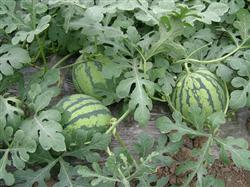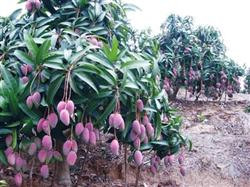Five measures for Scientific cultivation of small Watermelon in Spring

The cultivation of small watermelons in early spring has become a favorite project for many melon farmers, but due to climate and other reasons, the cultivation of small watermelons still needs a very scientific method. Here are 5 measures for scientific cultivation of small watermelons: 1. Temperature management. Because of the low natural temperature in early spring, the greenhouse film is mainly insulated after planting, and the greenhouse film is closed tightly, and the double layer or even multi-layer film is covered at night, so that the greenhouse temperature is not lower than 15 ℃. When the daytime temperature is high, the small arch greenhouse film can be opened for ventilation and reduce the temperature and humidity. The suitable greenhouse temperature is 20 ℃ ~ 25 ℃ in the early growth stage, 25 ℃ ~ 28 ℃ in the fruit setting stage, spraying expanding agent in the fruit expansion stage, and the temperature is controlled in 28 ℃ ~ 35 ℃. two。 Pruning and fruit thinning. The early growth of small watermelon is weak, and the fruit shape is small, so it is suitable to leave many vines and bear many fruits, so light pruning is the principle. Leave 5 true leaves to pick the heart when growing 5-6 true leaves, usually using two-vine pruning. When the vine grows to 40-50 cm, leave two strong and neat vines and remove the rest. After sitting on the melon, leave 10-15 leaves above the node to go to the top. Using stand cultivation, after two vines are pruned, do not hit the top of the two vines until the vines are full. After the watermelon is enlarged, the sun vine growing at the top should be determined by the principle of no shading. When climbing the ground for cultivation, you must disk the vine, that is, when the vine grows to 80 cm to 100 cm, first lead the two vines to the oblique rear of the plant rhizosphere, and then disk into a semicircle, so that the stem tip of the vine turns toward the front. The distance between the vines should be kept at 15-20 cm. In general, climbing cultivation uses multi-vine pruning, when the seedlings grow to 6-leaf stage to pick the heart, after the formation of seed vines, retain the similar growth of 3-5 vines, remove the rest of the vines. In this way, several vines can bear melon at the same time, making the shape of the melon neat. Small watermelon fruit shape is small, easy to bear melons, especially in multi-vine cultivation can continue to bear melons, more melons. Therefore, in the young melon stage, the fruit can be thinned properly according to the node position, the strength of the vine and the shape of the young melon to improve the commodity grade of the fruit. As for the number of melons per plant, the number of melons per plant varies according to different pruning methods, 3-4 melons can be left in double-vine pruning, and 5-7 melons can be left in 3, 4 and 5 vines. 3. Artificial pollination. Planting in protected areas in early spring has low temperature, weak light and few insects. Artificial pollination should be carried out in order to promote melon setting and increase melon setting rate. It is generally carried out at 8: 11 in the morning, in case of continuous overcast and rain and a small amount of pollen, the proper concentration of Zuoguoling can be dipped in flowers to promote fruit setting, so as to facilitate fruit expansion and spray dilatonin. But the concentration should not be too large, so as not to form deformed melons, cracked melons and so on. 4. Fertilizer and water management. The temperature is low and the growth is slow in early spring, the first topdressing is in the true leaf 3-leaf stage, 3 kg ammonium sulfate per mu, irrigated with water, 6 kg ammonium sulfate in 6-leaf stage, 10 kg ammonium sulfate plus 6 kg calcium superphosphate in vine extension stage, 10 kg ammonium sulfate plus 6 kg potassium chloride at the initial stage of melon and fruit expansion, open a shallow hole at 30 cm from the root, and water after application. Less watering should be done during the flowering and ripening period so as not to affect the melon setting rate and cause fruit cracking. Foliar fertilizer should be sprayed properly to supplement the nutrients needed in the growth process. 5. Harvest in time. It takes about 100 days from sowing to harvest. The early melons matured at 35-38 days after pollination, the middle melons matured at 32-35 days after pollination, and the late melons matured at 28-30 days after pollination. It can be harvested when the color of the pericarp changes from dark to light, the veins of the pericarp are slightly uneven and the leaflets outside the stalk are withered and yellow. It is necessary to keep a 6-8 cm long stalk during watermelon harvest, which can facilitate the harvest after morning dew is dry or in the evening. Small watermelon has thin skin, ready to eat after harvest, and the best quality. If transportation is needed, it should be packed with foam protection net and listed in boxes to ensure the quality of watermelon.
- Prev

Key points of high-yield cultivation techniques of watermelon in open field in spring
At present, it is the season of sowing and raising seedlings of watermelon in open field. in order to do a good job in watermelon planting and improve farmers' income, the key points of cultivation techniques of open field watermelon in spring are introduced as follows: first, varieties should be selected according to market demand. Select varieties with good quality, high yield and strong disease resistance, such as Qinghong.
- Next

Comprehensive management adopts new technology to protect flowers and fruits of mango.
Mango winter jujube fruit is easy to protect the fruit is difficult, from the young fruit stage to the white ripening period has been falling fruit, and what is puzzling is always falling big leftover small, so that jujube farmers are very distressed. In recent years, mango has been tested by taking various measures to protect flowers and fruits, and the following new technologies of comprehensive management have been obtained to solve this problem: 1.
Related
- Moge, come on! The staff of the peasant association in the producing area of cantaloupe were frightened when the crowd gathered.
- Causes and Solutions of low Fruit setting rate of Apple
- Symptoms and control measures of passion fruit virus disease
- Fruit growing lesson: how do apple orchards keep high yields?
- Can you build orchards in the mountains? What are the pros and cons?
- How to manage the coloring period of Crisson grape?
- This paper introduces the processing technology of two kinds of fig products.
- How much is a month for retired teachers in rural areas by 2020?
- How can strawberry planting increase sugar content? We should pay attention to management in many aspects.
- What are the cultivation techniques on how to improve the yield of golden fruit?

